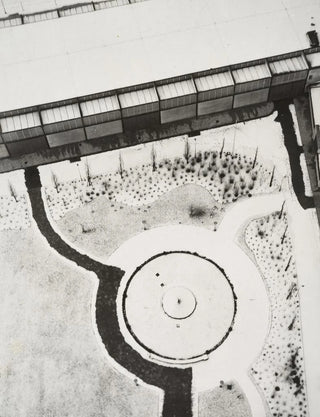Art print | From the Berlin radio tower - László Moholy-Nagy


View from behind

Frame (optional)
Since the Berlin radio tower - László Moholy-Nagy – Captivating introduction
In the fascinating universe of modern art, few works manage to capture the spirit of an era with as much intensity as "Since the Berlin radio tower" by László Moholy-Nagy. This iconic creation, completed in 1928, evokes not only an avant-garde vision of the city of Berlin but also a profound reflection on technology and visual perception. By immersing oneself in this piece, the viewer is invited to explore a reality transformed by modernity, where architectural lines blend with a vibrant urban dynamic. The art print of this work allows for a rediscovery of Moholy-Nagy's innovative perspective, while offering a glimpse into the aspirations of a society in full transformation.
Style and uniqueness of the work
The uniqueness of "Since the Berlin radio tower" lies in its kinetic approach and its ability to transcend the limits of traditional painting. Moholy-Nagy, as a pioneer of Bauhaus, adopts an aesthetic that combines geometric abstraction with visual dynamism. The forms intertwine, creating a perceptible movement that evokes the speed of modern life. The colors, although often limited to a restricted palette, are used with such mastery that they infuse a vibrant energy into the whole. This painting does not merely depict an urban landscape; it captures its very essence, transforming the viewer's gaze into an immersive experience. The light, omnipresent, plays a fundamental role, accentuating contrasts and revealing unsuspected facets of the city. Thus, Moholy-Nagy manages to create a work that dialogues with time and space, inviting everyone to redefine their perception of the world.
The artist and his influence
László Moholy-Nagy, born in Hungary in 1895, is an emblematic figure of the modernist movement. His artistic journey is marked by an incessant quest for innovation and experimentation. By integrating elements of photography, design, and painting, he established bridges between different disciplines, advocating a holistic vision of art. His time at Bauhaus was decisive, not only for

Matte finish

View from behind

Frame (optional)
Since the Berlin radio tower - László Moholy-Nagy – Captivating introduction
In the fascinating universe of modern art, few works manage to capture the spirit of an era with as much intensity as "Since the Berlin radio tower" by László Moholy-Nagy. This iconic creation, completed in 1928, evokes not only an avant-garde vision of the city of Berlin but also a profound reflection on technology and visual perception. By immersing oneself in this piece, the viewer is invited to explore a reality transformed by modernity, where architectural lines blend with a vibrant urban dynamic. The art print of this work allows for a rediscovery of Moholy-Nagy's innovative perspective, while offering a glimpse into the aspirations of a society in full transformation.
Style and uniqueness of the work
The uniqueness of "Since the Berlin radio tower" lies in its kinetic approach and its ability to transcend the limits of traditional painting. Moholy-Nagy, as a pioneer of Bauhaus, adopts an aesthetic that combines geometric abstraction with visual dynamism. The forms intertwine, creating a perceptible movement that evokes the speed of modern life. The colors, although often limited to a restricted palette, are used with such mastery that they infuse a vibrant energy into the whole. This painting does not merely depict an urban landscape; it captures its very essence, transforming the viewer's gaze into an immersive experience. The light, omnipresent, plays a fundamental role, accentuating contrasts and revealing unsuspected facets of the city. Thus, Moholy-Nagy manages to create a work that dialogues with time and space, inviting everyone to redefine their perception of the world.
The artist and his influence
László Moholy-Nagy, born in Hungary in 1895, is an emblematic figure of the modernist movement. His artistic journey is marked by an incessant quest for innovation and experimentation. By integrating elements of photography, design, and painting, he established bridges between different disciplines, advocating a holistic vision of art. His time at Bauhaus was decisive, not only for






